Metropolis of Kiev (Patriarchate of Moscow)
The Metropolis of Kiev is a
Following the
It is also a matter of dispute as to whether Moscow abided by the terms of the transfer from the
Background
Break with Constantinople
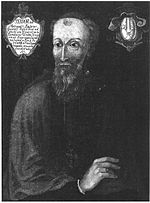
An
Meanwhile, in the Grand Duchy of Lithuania and the Kingdom of Poland, the rulers continued to recognise Isidore as metropolitan; Jonah was rejected and was unable to exercise any pastoral control beyond the borders of Muscovy. In 1458, while Isidore was still alive, his nephew Gregory the Bulgarian was appointed to succeed him as the Metropolitan of Kiev, Galicia and all Rus' by Patriarch Gregory III of Constantinople with the agreement of Pope Pius II.[15] In 1469, Patriarch Dionysius I of Constantinople also gave his blessing to Gregory's appointment.[16] Furthermore, he stated that Constantinople would not recognize any metropolitan ordained without its blessing.[17]
Reconciliation with Constantinople

Moscow's de facto independence (
In 1569, the Polish–Lithuanian Commonwealth was established. The Warsaw Confederation of 1573 secured the rights of minorities and religions in the new state.[21] Within this freedom, the Orthodox bishops from their primatial seat in the city of Novogrudok, together with the faithful in the Commonwealth, chose to remain loyal to the Ecumenical Patriarchate of Constantinople .
Union of Brest
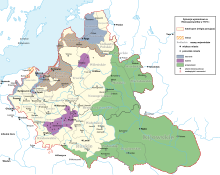
In 1588–1589, Patriarch Jeremias II of Constantinople traveled across Eastern Europe. Arriving in Moscow, he finally acknowledged the Russian Orthodox Church which had been estranged from Constantinople since the 1440s. While there, he consecrated Job of Moscow as the Eastern Orthodox Patriarch of Moscow and all Rus'. It is possible that Jeremias was imprisoned by the Ottomans and by the Muscovites, and may have been forced to elevate the see of Moscow to a patriarchy.[22]
Travelling on to the Commonwealth, Patriarch Jeremias II deposed the Metropolitan of Kiev, Onesiphorus Divochka. With the approval of King Sigismund III, he consecrated Michael Rohoza as the new "Metropolitan of Kiev, Galicia and all Ruthenia".[23]
In 1595–96, the majority of Eastern Orthodox
Officially, the Orthodox (but not the Eastern Catholic) Metropolis of Kiev in the Polish-Lithuanian Commonwealth was eliminated.
Conflicts between Muscovy, Cossacks and the Commonwealth
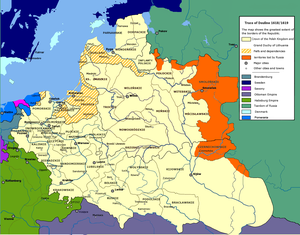
By the early years of the 17th century, the
By that time, the loyalty of the Zaporozhian hetmanate to the Commonwealth was only nominal. The Cossacks' strong historic allegiance to the Eastern Orthodox Church put them at odds with the Catholic-dominated Commonwealth. Tensions increased when Commonwealth policies turned from relative tolerance to the suppression of the Orthodox church, making the Cossacks strongly anti-Catholic. As a result, the Kiev and Chernihiv dioceses which lay in the hetmanate were lost to the Metropolis of Kiev, Galicia and all Rus'.
Establishment of the Exarchate of Ukraine

The formation of the
The metropolis in the Cossack Hetmanate
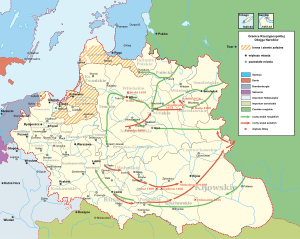
The
Commonwealth of Three Nations
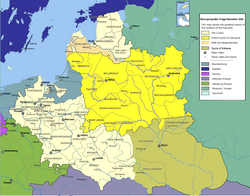
The official title of
By 1686, Russia had complete sovereignty over the lands of the Zaporozhian Sich and left-bank Ukraine, as well as the city of Kiev. The Treaty of Perpetual Peace (1686) which was concluded by Russia and the Commonwealth affirmed this reality.[37] As a result, the Greek Catholic population in those areas suffered oppression and many deaths. It also spelled an end to the independence and unity of the Hetman state. The Starodub, Chernihiv, and other territories in left-bank Ukraine went to Muscovy; the rest remained in the Commonwealth.
Establishment
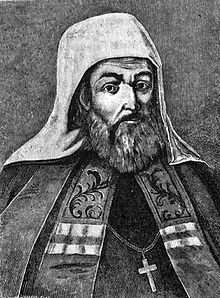
In 1681, the
Shortly after the signing of the treaty, through diplomatic pressure on the Sublime Porte and through bribery of leading churchmen, the patriarch of Constantinople gave the transfer canonical recognition.[40] The exact terms and conditions of the handover document signed by Patriarch Dionysius IV of Constantinople are disputed.[41][42][43][44]
As soon as Constantinople learned of Moscow's conclusion of an "eternal peace" with the Polish-Lithuanian Commonwealth, opposition to Patriarch Dionysius grew in the Synod. He was accused of having secret ties with Moscow. In 1687, the Council of Constantinople condemned Patriarch Dionysius for the transfer of the Metropolitanate of Kiev to Moscow, assessing this act as simony and deprived Dionysius of the patriarchal throne. Thus, the action of Patriarch Dionysius was declared illegal by the council (see 2018 Moscow–Constantinople schism).[45]
The metropolis under the Patriarchate of Moscow
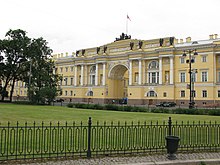
At the time of the transfer, the metropolis had six eparchies. Two of these were in
Chetvertinsky's two successors (Barlaam Yasinskyi and Joasaph Krokovskyi) were elected by councils in Kiev and were ordained in Moscow. The patriarch at that time in Moscow was Adrian of Moscow who resisted the Church reform of Peter the Great.[47] Nevertheless, Tsar Peter I got his way including the abolition of the right of the Kievan clergy to elect their metropolitan by free votes.
After Patriarch Adrian's death in 1700, Peter the Great prevented a successor from being named. The following year, on the advice of
Disestablishment
In 1721, according to the "Spiritual Regulations", the Metropolitanate of Kyiv was formally liquidated as an autonomous ecclesiastical region and became an ordinary diocese of the Moscow Patriarchate.
Downgrading to an archeparchy
When the Synod appointed Varlaam Vonatovych, he was installed, not as metropolitan, but as "Archbishop of Kiev, Galicia and Little Russia". From 1722 to 1742, the ancient Church was abolished while power in the Church passed to the monarch. Instead of being the centre of a separate church, Kiev had become an eparchy of the Russian Orthodox Church.
In 1727, when the hetmanate was restored during the reign of Peter II, Barlaam Vanatovych sought the restoration of the title of metropolitan. He voiced the protests of the Ukrainian clergy against the violation of the rights and privileges of the Church. This resulted in his removal and arrest. In the same year, the Synod, contrary to the promised privileges given to the metropolitanate, appointed the Moscovite Joachim Strukov as Bishop of Pereiaslav. He was ordained in St. Petersburg, without the participation of the Metropolitan of Kyiv in his election and approval.
On 2 August 1730, the archbishop and the cathedral were summoned to Moscow, where they were all arrested, stripped of their titles, and sentenced to life in exile.
Reestablishment with fewer privileges
In 1731 the tsar elevated Raphael Zaborovsky to the office of archbishop of Kiev in succession to Varlaam Vonatovych. The Kiev clergy petitioned Empress Elizabeth to renew the metropolitan's title, which she did in June 1743.
In 1748, Tymofiy Shcherbatsky was appointed the new metropolitan. The functions and rights of the metropolitan were very limited, so Timothy focused on the development of the Kyiv Academy and the restoration of the printing house at the Kyiv-Pechersk Lavra. In protest at Moscow's interference in the affairs of the metropolis, in 1757 he wrote a letter to the Synod requesting his dismissal from the metropolitan chair. Under the new metropolitan, Arseniy of Mohyla, the right of the Metropolitan of Kyiv was even more limited. In 1770, Empress Catherine the Great, through her appointees in the Synod, removed the words "and Little Rus" from the title Metropolitan of Kyiv, Galicia and Little Rus.
Appropriation of Church assets
The next step was the secularization of church wealth. At that time, the Ukrainian church owned huge estates, at the expense of which monasteries carried out extensive cultural and educational work, maintained schools, hospitals, and helped the needy. In the mid-1760s, Catherine II aimed to take away these lands, but was met with strong resistance from the clergy. However, she did not give up her plan. In the 1780s, more favorable conditions were created for the implementation of this plan, and on April 10, 1786, the empress issued a decree on the secularization of monastic and ecclesiastical lands. As a result, 46 monasteries were closed. Metropolitan Gavriil Kremenetsky (1770–1783) systematically pursued a centralizing policy in the Ukrainian Church. Bishops, hegumen, priests and monks became virtual state employees. In 1775, following the destruction of the Zaporozhian Sich, the Kherson eparchy (subordinated to the Synod) was formed, a part of the Metropolitanate of Kyiv was annexed to it. In the 18th century, most Kievan archeparchs were Ukrainian nationals; in the 19th century, most were Russian nationals.
Russification of the nation and the Church

The policy of active Russification of Ukraine and cultural assimilation of the Ukrainian people continued. According to historian Serhii Plokhy, "the abolition of the Hetmenate and the gradual elimination of its institution and military structure ended the notion of partnership and equality between Great and Little Russia imagined by generations of Ukrainian intellectuals."[49] Russian imperialism relied on the support of the Russian clergy. At the same time, despite subordination to the Russian Orthodox Church and the Synod, the Ukrainian dioceses still retained some peculiarities in organization and church rites.
Policy decisions of the Russian government resulted in Ukrainian Orthodoxy gradually losing its connection with the Ukrainian people, culture and literature. The government decreed that books could only be published in Ukraine that strictly accorded with Russian texts. This policy lasted until 1917. In the Ukrainian Orthodox Trebnik of 1695, the names of no saints that were added to the Moscow lunar calendar as Moscow saints. Only in 1784 were all Ukrainian churches ordered to accept the Russian Lunar Dictionary. Ukrainian worship was translated into Moscow, Ukrainian theological and church books were banned.
In 1769, the Archimandrite of the Kyiv-Pechersk Lavra — Zosima Valkevych — asked the Synod for permission to print Ukrainian primers, because the people did not understand Russian and do not want to buy them. However, the Synod refused and even ordered the removal of those primers already in circulation. The situation was similar in education. Since 1784 all lectures at the Kyiv-Mohyla Academy have been given in Russian. The same was introduced in all schools in Ukraine. In 1800, the Synod issued a decree banning the construction of Ukrainian Baroque churches. In 1810, the Kyiv-Mohyla Academy was closed and the Theological Academy was established in its place.
List of metropolitans and archbishops
- Metropolitan consecrationto Moscow instead of Constantinople. Until 1688, he was styled "Metropolitan of Kyiv, Galicia, and all Ruthenia".
- Metropolitan Barlaam Yasinskyi (1690–1707)[50]
- Metropolitan Joasaph Krokovskyi (1708–1718)[50]
- In 1718 Peter the Great abolished metropolitan.
- Archbishop Varlaam (Vanatovich) (1722–1730), [50]
- Archbishop Raphael Zaborovsky (1731–1743); from 1743 to 1747 he served as Metropolitan[50]
- Metropolitan Timothy Shcherbatsky (1748–1757)[50]
- Metropolitan Arsenius Mohylyansky (1757–1770)[50] In 1767 Empress Catherine the Great stripped Metropolitan Arsenius of the "of all Little Rus" part of his title.
Metropolitans of Kyiv and Galicia (1770–1921)
In 1770, the Romanov civil authorities stripped the metropolis of its
- Gabriel Kremenetsky, 1770–1783[50]
- Samuel Mstislavsky, 1783–1796 [50]
- Hierotheus Malytsky, 1796–1799 [50]
- Gabriel II, 1799–1803 [50]
- Serapion Alexandrovsky, 1803–1822 [50]
- Eugene Bolkhovitinov, 1822–1837 [50]
- Philaret Amphiteatrov, 1837–1857 [50]
- Isidore Nikolsky, 1858–1860 [50]
- Arsenius II, 1860–1876 [50]
- Philotheus Uspensky, 1876–1882 [50]
- Platon Gorodetsky, 1882–1891 [50]
- Joanicius Rudnev, 1891–1900 [50]
- Theognostus Lebedev, 1900–1903 [50]
- Flavian Gorodetsky, 1903–1915 [50]
- Vladimir Bogoyavlensky, 1915–1918 [50]
- Nicodemus (Krotkov), 1918 (as bishop of Chyhyryn)
- Russian Orthodox Church Outside Russia(ROCOR).
- Nazarius Blinov, 1919–1921 [50]
Notes
- ISBN 1610488938(page 10).)
- ^ Sometimes also spelled as Laetentur Coeli, Laetantur Caeli, Lætentur Cæli, Lætentur Cœli, or Lætantur Cæli, and occasionally referred to as the Act of Union or "Decree of Union".
- ^ "...the metropolitan in Kiev bore the title "metropolitan of Kiev and All Rus’," never "metropolitan of the Rus’ Land," just as the metropolitan of Moscow bore the title "metropolitan of Moscow and All Rus’," not "metropolitan of the Rus’ Land.""
- ^ In Russian: Патриарх Московский и всея России и северных стран
References
- Mykola Andrusiak. "Józef Szumlański, pierwszy biskup unicki lwowski, 1667-1708 (Open Library". Openlibrary.org. Retrieved 2012-08-25.
From This article incorporates text from a publication now in the public domain: Valois, Joseph Marie Noel (1911). "Basel, Council of". In Chisholm, Hugh (ed.). Encyclopædia Britannica. Vol. 3 (11th ed.). Cambridge University Press. pp. 463–464.
Other sources:
- ^ Bainton, Roland H. (1966), Christendom: A Short History of Christianity, vol. I, New York: Harper & Row, p. 119
- ^ Billington, James H. (1966), The Icon and the Axe: An Interpretive History of Russian Culture, New York: Random House, p. 67
- ^ "К 20-летию Благословенной Грамоты Святейшего Патриарха Московского и всея Руси Алексия II о даровании Украинской Православной Церкви самостоятельности в управлении / Статьи / Патриархия.ru". Патриархия.ru.
- ^ Metropolitan Onufriy of Chernivtsi and Bukovina elected head of Ukrainian Orthodox Church (Moscow Patriarchate) Archived 2014-08-13 at the Wayback Machine, Interfax-Ukraine (13 August 2014)
- Radio Free Europe (in Ukrainian). Retrieved 2023-01-06.. Official website of the Ukrainian Orthodox Church (Moscow Patriarchate) (in Ukrainian). 2022-12-31. Retrieved 2023-01-06.
"The Charter of the UOC does not contain any provisions that could even hint at the connection with Moscow — the Head of the Legal Department". Official website of the Ukrainian Orthodox Church (Moscow Patriarchate). 2022-12-31. Retrieved 2023-01-06.
"The UOC priest protested his inclusion in the ROC Publishing Council" - ^ "Οἰκουμενικόν Πατριαρχεῖον". ec-patr.org. Archived from the original on October 7, 2018. Retrieved December 28, 2018.
- Ecumenical Patriarchate. 11 October 2018. Retrieved 2018-10-12.
The Holy Synod discussed in particular and at length the ecclesiastical matter of Ukraine, in the presence of His Excellency Archbishop Daniel of Pamphilon and His Grace Bishop Hilarion of Edmonton, Patriarchal Exarchs to Ukraine, and following extensive deliberations decreed:
1) To renew the decision already made that the Ecumenical Patriarchate proceed to the granting of Autocephaly to the Church of Ukraine. [...]
4) To revoke the legal binding of the Synodal Letter of the year 1686 [...] - ^ "Patriarch Bartholomew signs Tomos of autocephaly of Orthodox Church of Ukraine". risu.org.ua. 5 January 2019. Retrieved 2019-01-05.
- ^ Joseph Gill, Personalities of the Council of Florence, pg68
- ^ "Bulla Laetentur caeli (6 Iul. 1439), de unione Graecorum". www.vatican.va. Retrieved 27 December 2022.
- ^ ИОНА // Orthodox Encyclopedia
- ^ Shubin 2004, pp. 124–129.
- ^ E. E. Golubinskii, Istoriia russkoi tserkvi (Moscow: Universitetskaia tipografiia, 1900), vol. 2, pt. 1, p. 469.
- ^ THE RISE AND DEMISE OF THE MYTH OF THE RUS’ LAND, CHARLES J. HALPERIN, 2022, p98. ISBN 9781802700114
- ^ Ukrainian Catholic Church: part 1. Farlex. The Free Library.
- ^ Yarotskyi, P. Division of the Church Metropolis of Kiev (Поділ Київської митрополії) Archived 2019-11-13 at the Wayback Machine. RISU Library ("Lyudyna i svit" magazine). 1998
- ^ Shubin 2004, pp. 130–132.
- ^ Shubin 2005, pp. 17, 35.
- ^ Bodin 2015, p. 16.
- ^ Shubin 2005, p. 26.
- ^ Stone, Daniel, The Polish-Lithuanian State, 1386–1795, Seattle and London: University of Washington Press, 2001.
- ISBN 978-0-300-10586-5.
- ^ a b Hudziak, B.O., Tu, O.Yu. The 1596 Brest Church Union (БЕРЕСТЕЙСЬКА ЦЕРКОВНА УНІЯ 1596). Encyclopedia of History of Ukraine.
- ^ Church Union of Berestia. Encyclopedia of Ukraine
- ^ Pelesz, Julian (1881). Geschichte der Union der ruthenischen Kirche mit Rom. Woerl. pp. 1083–84.
- ^ Magocsi 1996, pp. 255–256; Zhukovsky 1988, p. 359.
- ^ Siecienski, A. Edward (2019). Orthodox Christianity: A Very Short Introduction. Very Short Introductions. New York City: Oxford University Press. p. 108.
- ^ Polish-Cossack War
- ^ "Khmelnitsky Massacre in Polonnoe - סגולה". Archived from the original on 2021-02-28.
- Britannica
- ^ Government portal :: Cossack era
- ^ Piotr Kroll (August 6, 2012). "Kozaczyzna, Rzeczpospolita, Moskwa" [Cossack Country, the Republic, Moscow] (in Polish). Rzeczpospolita. Retrieved August 20, 2016.
- ^ The 1658 treaty of Hadiach (Гадяцький договір 1658 року) Archived 2020-09-26 at the Wayback Machine. Ukrayinskyi istoryk.
- ^ Alexander Basilevsky (2016): Early Ukraine: A Military and Social History to the Mid-19th Century (p. 311)
- ^ Т.Г. Таирова-Яковлева, Иван Выговский // Единорогъ. Материалы по военной истории Восточной Европы эпохи Средних веков и Раннего Нового времени, вып.1, М., 2009: Под влиянием польской общественности и сильного диктата Ватикана сейм в мае 1659 г. принял Гадячский договор в более чем урезанном виде. Идея Княжества Руського вообще была уничтожена, равно как и положение о сохранении союза с Москвой. Отменялась и ликвидация унии, равно как и целый ряд других позитивных статей.
- ^
ISBN 0-8020-0830-5
- ISBN 978-0-313-26007-0.
- ^ Mykola Andrusiak, Józef Szumlański, pierwszy biskup unicki lwowski, 1667-1708, Openlibrary.org. Retrieved 2012-08-25.
- ^ Encyclopedia of the Russian Orthodox Church - Gedeon Chetvertinsky
- ^ KOHUT, ZENON E. "The Problem of Ukrainian Orthodox Church Autonomy in the Hetmanate (1654-1780s)." Harvard Ukrainian Studies, vol. 14, no. 3/4, 1990, pp. 364–76. JSTOR, http://www.jstor.org/stable/41036393. Accessed 12 Mar. 2023.
- ^ РПЦ: вмешательство Константинополя в ситуацию на Украине может породить новые расколы: Митрополит Волоколамский Иларион завил, что Русская православная церковь представит доказательства неправомерности притязаний Константинополя на Украину TASS, 1 September 2018.
- ^ Ecumenical Patriarch Takes Moscow Down a Peg Over Church Relations with Ukraine orthodoxyindialogue.com, 2 July 2018.
- Bartholomewafter the memorial service for the late Metropolitan of Perge, Evangelos) The official website of the Ecumenical Patriarchate, 2 July 2018.
- ^ Константин Ветошников. «Передача» Киевской митрополии Московскому патриархату в 1686 году: канонический анализ risu.org.ua, 25 December 2016.
- from the original on 2 May 2020. Retrieved 2019-01-26.
- ^ KOHUT, ZENON E. "The Problem of Ukrainian Orthodox Church Autonomy in the Hetmanate (1654-1780s)." Harvard Ukrainian Studies, vol. 14, no. 3/4, 1990, pg 367. JSTOR, http://www.jstor.org/stable/41036393. Accessed 12 Mar. 2023.
- ^ Lewitter, L. R. "The Church Reform of Peter the Great." The Slavonic and East European Review, vol. 50, no. 119, 1972, pp. 276–87. JSTOR, http://www.jstor.org/stable/4206530. Accessed 11 Mar. 2023.
- ^ Chisholm, Hugh, ed. (1911). . Encyclopædia Britannica. Vol. 28 (11th ed.). Cambridge University Press. p. 908.
- OCLC 1090811885.)
{{cite book}}: CS1 maint: numeric names: authors list (link - ^ a b c d e f g h i j k l m n o p q r s t u v w x UOC-MP 2011.
